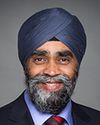That is a very good question. In fact, that's exactly what we're trying to achieve. When it was originally envisioned during the consultations with Canadians, for the defence policy, there was obviously a need for the Canadian Armed Forces to make sure that, as a force of last resort, it would be able to respond. However, as you have seen, it's been so frequent that the Canadian Armed Forces have been called upon. Therefore, it is important for all of us at municipal, provincial and federal levels to assess what types of resources are going to be needed to deal with the increased frequency of responding to emergencies.
This is what is being developed now. We're having federal, provincial and territorial meetings across the country. I am also meeting with mayors to determine, province by province and territory by territory, what resources are going to be needed. We need to make sure, right down to the municipal level, what types of resources are going to be needed, what type of training is going to be required and what types of resources are going to be needed at the provincial level and then at the federal level.
Putting the CAF aside, we want to know the type of resource that needs to be in the right place at the right time, and then look at the CAF only as a last resort. For example, we are looking at options right now for how to have more firefighters. Yes, we need to train more type 1 firefighters, but the Canadian Armed Forces provides type 3 firefighters. We need to look at how we could train type 2, so there are different options being looked at. It's premature to talk about it just yet.
We are analyzing what types of things the Canadian Armed Forces has been asked to do that could have been done by somebody else, and we are looking at the Canadian Armed Forces only for what is absolutely needed. For example, there are certain things that only the Canadian Armed Forces can do, and evacuation is one. When we need to do very quick evacuation and we don't have time to contract aircraft, we want to be able to move our resources in quickly. The Canadian Armed Forces also has the capability to fly at night, and those types of things in remote areas are also very important.
We're going do that assessment, and more importantly, what we want to do as we look at this is to exercise that area. That way, we're not only using the CAF less, but also looking at how we prevent emergencies that go beyond the capacity of municipal or provincial levels.





